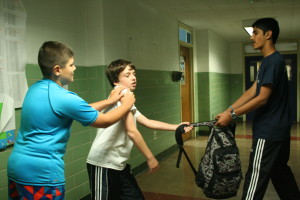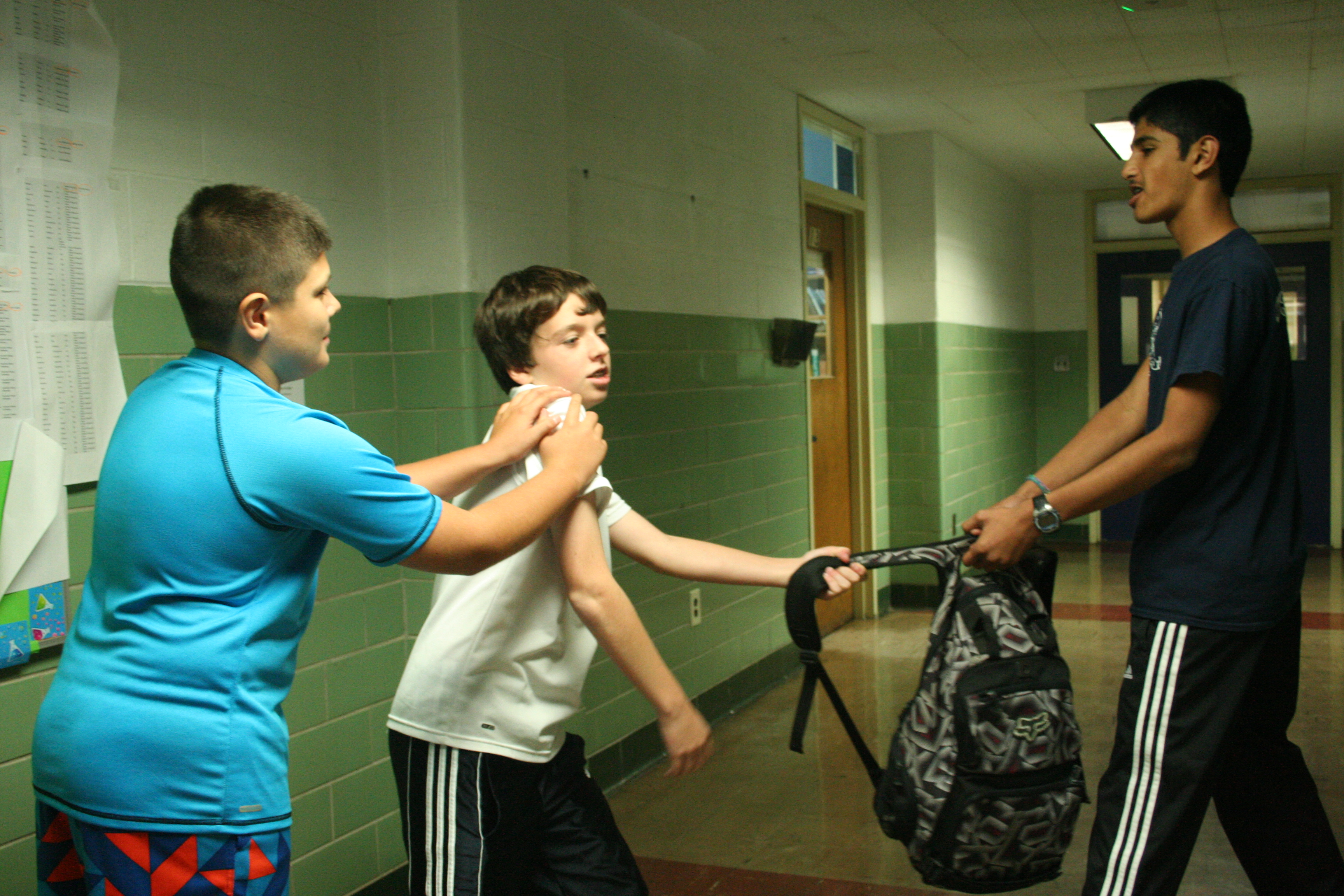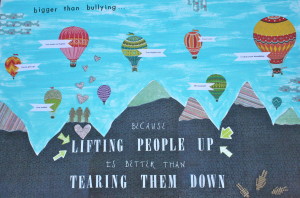Most of the work I do with my Self Esteem Through Art program occurs BEFORE a bullying incident has taken place. I work in schools and with groups to boost people’s self-esteem, strengthen their moral compass, and tease out the brilliance in their character. Much like building your physical muscles to bear a greater load, your internal character muscles need building as well so they can weather attacks, tests, and challenges.
My latest Podcast goes into GREAT detail on a topic that is at the forefront of everyone’s mind lately: BULLYING. Bullying is a serious thing, but it has also unfortunately become a wastebasket term for all types of behavior. And, with all of the awareness and media coverage, it is now beginning to suffer a massive case of mistaken identity. By labeling every single childhood behavior as bullying, we are beginning to minimize and distract from the real problem. Unsavory behavior in children (and adults) falls into three DISTINCT categories, and while there are similarities, they are ALL uniquely different.
Let’s begin by going over that and clarifying any misconceptions: 
IS IT BULLYING?
Cruel and hurtful behavior can be defined three ways. There is mean behavior. There is conflict. And there is bullying.
Mean Behavior:
Mean behavior, where I don’t endorse it, is common. We ALL have the capacity to be mean, regardless of how spiritual, kind, or tuned into source we are. We say unkind things, we give unkind looks, we gossip and make assumptions, and sometimes we even hurt someone unintentionally because we don’t know their threshold for our behavior. One spouse hurts another spouse, one sibling says something unkind to another sibling, a child lashes out at a parent, an employer cuts into an employee, we judge based on appearance or the color of someone’s skin…it happens all the time. But, the key with mean behavior is that it is UNCOMMON and it can also be UNINTENTIONAL. Here are some characteristics:
- The behavior is occasional at best, and is often uncharacteristic of the person exhibiting it.
- Sometimes is the result of a lack of impulse control or a filter (i.e. someone answers a question honestly, but the response is hurtful).
- The person who was mean typically feels remorse and has a desire to rectify the situation and/or change their behavior.
- Mean behavior is often one-sided, meaning that someone is mean to someone else, but that person does not retaliate or engage.
- Mean behavior has been around since the beginning of time and if it meets the above parameters, IT IS NOT BULLYING!
Conflict:
One step escalated from mean behavior is conflict. Conflict can be uncomfortable and hurtful. But conflict is considered a normal part of life. As with mean behavior, there is often a desire on the part of a parent(s) to jump in and intervene in the situation. I would caution against that and I will explain why in this post. Characteristics of conflict:
- Conflict requires two or more parties to take place.
- All parties in a conflict situation possess EQUAL power in the relationship.
- Both people might be mad, upset, or angry, but one person is not looking to gain power over the other and the scales are weighted equally in each person’s favor.
- After a conflict, one or both parties will feel remorse and seek to rectify the situation so they can move on.
- Conflict will happen occasionally and is not usually serious or emotionally damaging.
- Conflict resolution skills are important and kids should be taught how to appropriately and expediently deal with it in a way that makes sense for both parties. (Keep it small and keep it classy)
- *Conflict can occur more regularly in people who spend a great deal of time together (i.e. siblings, best friends, spouses, parent/child).
Some examples of conflict are heated debates over religion/politics/belief systems, disagreements over sports, possessions, or “taking turns.” Smack talk in sports is another good example. I understand that the temptation as a parent is there for you to jump right in and save the day so you can spare your child’s feelings, but please think twice before doing that. It is so easy for us to get overly involved these days, but try to spend at least some of that time talking to, role playing with, and teaching tools for how to cope with these situations. More than you saving the day, your kids need tools and life skills for when they leave the nest…the time to teach those is now. (I will provide resources for this later in the blog)
Bullying:
Bullying is so, so serious. The consequences are far-reaching and potentially life-altering. There is no denying that! But, kids are not inherently mean or inherently bullies. It is learned behavior and one that we can minimize and/or prevent with tools, techniques, and time. In this day and age, there is so much press, so much awareness about bullying—but not enough bully prevention programs in the places we need them and with the frequency that is required! Some characteristics of bullying:
- Where conflict is oft considered a rite of passage, bullying is NOT.
- Bullying is an act of ego. Kids with higher self-esteems tend to bully less.
- In bullying, there is a definite imbalance of power. The scales are heavily weighted in favor of one side.
- There is definite intent (to harm, embarrass, inflict emotional or physical damage) with deliberate actions.
- Where mean behavior and conflict tend to be infrequent occurrences, bullying is REPEATED. It can be categorized as unrelenting.
- There is the threat, direct or implied, of serious physical or emotional harm.
- Bullies exhibit very little (or no) emotional reaction. They are calm, cool, collected while the target is visibly upset or rattled.
- Bullies don’t offer up much in the way of remorse or willingness to solve the problem and move on.
- Bullies are BIG ON BLAME!! They do not accept responsibility for their own actions.
- They use a cause as an injustifiable and invalid excuse for their effect. (They frequently say things like “It’s not my fault, I did this because, They deserved it, They got what was coming to them,” etc).
- Bullies don’t negotiate, they BLAME.
- This behavior can happen in person or online (cyberbullying)
- When online, the bully often poses anonymously or falsely assumes the identity of another to inflict their harm.
- Cyberbullying is particularly dangerous because of its ability to “go viral.”
In my Podcast, I go into great depth about what IS bullying vs. what ISN’T bullying. It is critical that you educate yourselves on the differences. Because, just as bullying is serious, so are false accusations of bullying. Just like with rape, you better be 100% certain that you are well-versed in what is going on before you slap that label on someone. If everyone’s a bully, then no one’s a bully. If everyone’s a victim, then no one’s a victim.
What Else Do You Need To Be Aware Of?
GHOSTING: Have you ever heard of “Ghosting?” There are Apps that allow you to send text messages and photos under the guise of someone else’s phone #. This is a technique that is used a great deal in cyberbullying. Example: Susie pretend she is John and utilizes his phone # to send threatening text messages to Jane. John gets blamed and Susie, the actual bully, goes undetected because people aren’t aware of this threat. Don’t believe me? Google it. Or visit an App store.
CATFISHING: Catfishing is another common problem. Often done by parents to “spy” on their kids or their kids’ friends, it is defined pretending to be someone you are not online to create false identities, particularly to pursue deceptive online romances or practices. It was made popular in 2006 by a mother who was spying on her daughter’s former friend online. She then bullied this girl and the young girl ended up taking her own life.
**ASSUMING A FALSE IDENTITY ONLINE IS NEVER OKAY, PARTICULARLY IF THERE IS INTENT TO INFLICT HARM.
What Signs Should You Look For?
I go into great detail in my Podcast of what signs you can look for. Signs will differ, depending on whether a person is bullying or being bullied. I strongly encourage you to listen to the Podcast and know the warning signs. A child’s life could depend on it.
What Can You Do?
There are many things you can do to prevent, manage, and help someone recover from an incident with a meanie, a conflict situation, or a bullying incident.
- First and foremost, I recommend that you become an expert. Knowledge is power. Ask questions. Dig deeper. Be in the know. Read. Learn. Become focused on prevention.
- Build character. Yours. Theirs. We all win when people act with a strength of character.
- Be a constant presence in your child(ren)’s lives. Both in-person and online. It takes time and it can be exhausting…but do it anyways. You will be rewarded by learning so much more about your children and their friends than you ever imagined.
- Encourage your kids to ask questions. Think Johnny sent you a nasty text? CALL him and ASK him instead of engaging in a war of words.
- Beware of anonymous sites that promote bullying and aggressive behavior. Some of the ones to watch are ask.fm, Kik, Snapchat, Vine, Instagram, and Yik Yak. There is also Facebook and Twitter. New ones crop up all the time. All of your children’s online accounts should be monitored aggressively.
- If you are having problems and they aren’t working themselves out, seek out the help of an trusted administrator, friend, or authority figure.
Resources:
Websites:
Books:
This is not a complete list, nor is it an exhaustive one. There is SO much more that can be said on this and so many more resources that could be included. We can get to those in another post. It has taken me hours and hours to put both the Podcast and this blog post out into the world. I hope you have found it beneficial.
Act with love,
Jenn


